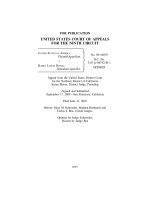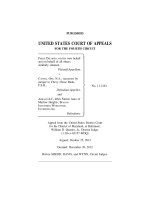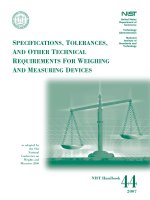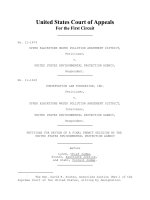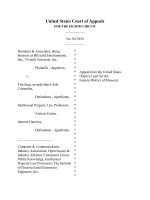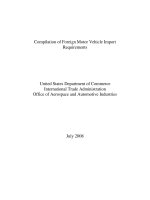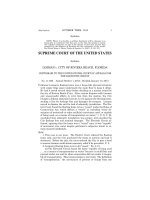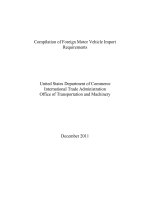CERTIORARI TO THE UNITED STATES COURT OF APPEALS FOR THE ELEVENTH CIRCUIT pdf
Bạn đang xem bản rút gọn của tài liệu. Xem và tải ngay bản đầy đủ của tài liệu tại đây (854.72 KB, 32 trang )
1
(Slip Opinion) OCTOBER TERM, 2012
Syllabus
NOTE: Where it is feasible, a syllabus (headnote) will be released, as is
being done in connection with this case, at the time the opinion is issued.
The syllabus constitutes no part of the opinion of the Court but has been
prepared by the Reporter of Decisions for the convenience of the reader.
See United States v. Detroit Timber & Lumber Co., 200 U. S. 321, 337.
SUPREME COURT OF THE UNITED STATES
Syllabus
LOZMAN v. CITY OF RIVIERA BEACH, FLORIDA
CERTIORARI TO THE UNITED STATES COURT OF APPEALS FOR
THE ELEVENTH CIRCUIT
No. 11–626. Argued October 1, 2012—Decided January 15, 2013
Petitioner Lozman’s floating home was a house-like plywood structure
with empty bilge space underneath the main floor to keep it afloat.
He had it towed several times before deciding on a marina owned by
the city of Riviera Beach (City). After various disputes with Lozman
and unsuccessful efforts to evict him from the marina, the City
brought a federal admiralty lawsuit in rem against the floating home,
seeking a lien for dockage fees and damages for trespass. Lozman
moved to dismiss the suit for lack of admiralty jurisdiction. The Dis-
trict Court found the floating home to be a “vessel” under the Rules of
Construction Act, which defines a “vessel” as including “every de-
scription of watercraft or other artificial contrivance used, or capable
of being used, as a means of transportation on water,” 1 U. S. C. §3,
concluded that admiralty jurisdiction was proper, and awarded the
City dockage fees and nominal damages. The Eleventh Circuit af-
firmed, agreeing that the home was a “vessel” since it was “capable”
of movement over water despite petitioner’s subjective intent to re-
main moored indefinitely.
Held:
1. This case is not moot. The District Court ordered the floating
home sold, and the City purchased the home at auction and had it
destroyed. Before the sale, the court ordered the City to post a bond
to ensure Lozman could obtain monetary relief if he prevailed. P. 3.
2. Lozman’s floating home is not a §3 “vessel.” Pp. 3–15.
(a) The Eleventh Circuit found the home “capable of being used
. . . as a means of transportation on water” because it could float and
proceed under tow and its shore connections did not render it incapa-
ble of transportation. This interpretation is too broad. The definition
of “transportation,” the conveyance of persons or things from one
2 LOZMAN v. RIVIERA BEACH
Syllabus
place to another, must be applied in a practical way. Stewart v. Du-
tra Constr. Co., 543 U. S. 481, 496. Consequently, a structure does
not fall within the scope of the statutory phrase unless a reasonable
observer, looking to the home’s physical characteristics and activities,
would consider it designed to a practical degree for carrying people or
things over water. Pp. 3–5.
(b) But for the fact that it floats, nothing about Lozman’s home
suggests that it was designed to any practical degree to transport
persons or things over water. It had no steering mechanism, had an
unraked hull and rectangular bottom 10 inches below the water, and
had no capacity to generate or store electricity. It also lacked self-
propulsion, differing significantly from an ordinary houseboat.
Pp. 5–6.
(c) This view of the statute is consistent with its text, precedent,
and relevant purposes. The statute’s language, read naturally, lends
itself to that interpretation: The term “contrivance” refers to some-
thing “employed in contriving to effect a purpose”; “craft” explains
that purpose as “water carriage and transport”; the addition of “wa-
ter” to “craft” emphasizes the point; and the words, “used, or capable
of being used, as a means of transportation on water,” drive the point
home. Both Evansville & Bowling Green Packet Co. v. Chero Cola
Bottling Co., 271 U. S. 19, and Stewart, supra, support this conclu-
sion. Evansville involved a wharfboat floated next to a dock, used to
transfer cargo, and towed to harbor each winter; and Stewart in-
volved a dredge used to remove silt from the ocean floor, which car-
ried a captain and crew and could be navigated only by manipulating
anchors and cables or by being towed. Water transportation was not
the primary purpose of either structure; neither was in motion at rel-
evant times; and both were sometimes attached to the ocean bottom
or to land. However, Stewart’s dredge, which was regularly, but not
primarily, used to transport workers and equipment over water, fell
within the statutory definition while Evansville’s wharfboat, which
was not designed to, and did not, serve a transportation function, did
not. Lower court cases, on balance, also tend to support this conclu-
sion. Further, the purposes of major federal maritime statutes—e.g.,
admiralty provisions provide special attachment procedures lest a
vessel avoid liability by sailing away, recognize that sailors face spe-
cial perils at sea, and encourage shipowners to engage in port-related
commerce—reveal little reason to classify floating homes as “vessels.”
Finally, this conclusion is consistent with state laws in States where
floating home owners have congregated in communities. Pp. 6–11.
(d) Several important arguments made by the City and its amici
are unavailing. They argue that a purpose-based test may introduce
a subjective element into “vessel” determinations. But the Court has
3 Cite as: 568 U. S. ____ (2013)
Syllabus
considered only objective evidence, looking to the views of a reasona-
ble observer and the physical attributes and behavior of the struc-
ture. They also argue against using criteria that are too abstract,
complex, or open-ended. While this Court’s approach is neither per-
fectly precise nor always determinative, it is workable and consistent
and should offer guidance in a significant number of borderline cases.
And contrary to the dissent’s suggestion, the Court sees nothing to be
gained by a remand. Pp. 11–14.
(e) The City’s additional argument that Lozman’s floating home
was actually used for transportation over water is similarly unper-
suasive. P. 14.
649 F. 3d 1259, reversed.
B
REYER, J., delivered the opinion of the Court, in which ROBERTS,
C. J., and SCALIA, THOMAS, GINSBURG, ALITO, and KAGAN, JJ., joined.
S
OTOMAYOR, J., filed a dissenting opinion, in which KENNEDY, J., joined.
_________________
_________________
1 Cite as: 568 U. S. ____ (2013)
Opinion of the Court
NOTICE: This opinion is subject to formal revision before publication in the
preliminary print of the United States Reports. Readers are requested to
notify the Reporter of Decisions, Supreme Court of the United States, Wash-
ington, D. C. 20543, of any typographical or other formal errors, in order
that corrections may be made before the preliminary print goes to press.
SUPREME COURT OF THE UNITED STATES
No. 11–626
FANE LOZMAN, PETITIONER v. THE CITY OF
RIVIERA BEACH, FLORIDA
ON WRIT OF CERTIORARI TO THE UNITED STATES COURT OF
APPEALS FOR THE ELEVENTH CIRCUIT
[January 15, 2013]
JUSTICE BREYER delivered the opinion of the Court.
The Rules of Construction Act defines a “vessel” as in-
cluding “every description of watercraft or other artificial
contrivance used, or capable of being used, as a means of
transportation on water.” 1 U. S. C. §3. The question before
us is whether petitioner’s floating home (which is not self-
propelled) falls within the terms of that definition.
In answering that question we focus primarily upon the
phrase “capable of being used.” This term encompasses
“practical” possibilities, not “merely . . . theoretical” ones.
Stewart v. Dutra Constr. Co., 543 U. S. 481, 496 (2005).
We believe that a reasonable observer, looking to the
home’s physical characteristics and activities, would not
consider it to be designed to any practical degree for carry-
ing people or things on water. And we consequently con-
clude that the floating home is not a “vessel.”
I
In 2002 Fane Lozman, petitioner, bought a 60-foot by
12-foot floating home. App. 37, 71. The home consisted of
a house-like plywood structure with French doors on three
sides. Id., at 38, 44. It contained a sitting room, bedroom,
2 LOZMAN v. RIVIERA BEACH
Opinion of the Court
closet, bathroom, and kitchen, along with a stairway
leading to a second level with office space. Id., at 45–66.
An empty bilge space underneath the main floor kept it
afloat. Id., at 38. (See Appendix, infra, for a photograph.)
After buying the floating home, Lozman had it towed
about 200 miles to North Bay Village, Florida, where he
moored it and then twice more had it towed between
nearby marinas. In 2006 Lozman had the home towed a
further 70 miles to a marina owned by the city of Riviera
Beach (City), respondent, where he kept it docked. Brief
for Respondent 5.
After various disputes with Lozman and unsuccessful
efforts to evict him from the marina, the City brought
this federal admiralty lawsuit in rem against the floating
home. It sought a maritime lien for dockage fees and
damages for trespass. See Federal Maritime Lien Act, 46
U. S. C. §31342 (authorizing federal maritime lien against
vessel to collect debts owed for the provision of “neces-
saries to a vessel”); 28 U. S. C. §1333(1) (civil admiralty
jurisdiction). See also Leon v. Galceran, 11 Wall. 185
(1871); The Rock Island Bridge, 6 Wall. 213, 215 (1867).
Lozman, acting pro se, asked the District Court to dis-
miss the suit on the ground that the court lacked admi-
ralty jurisdiction. See 2 Record, Doc. 64. After summary
judgment proceedings, the court found that the floating
home was a “vessel” and concluded that admiralty juris-
diction was consequently proper. Pet. for Cert. 42a. The
judge then conducted a bench trial on the merits and
awarded the City $3,039.88 for dockage along with $1 in
nominal damages for trespass. Id., at 49a.
On appeal the Eleventh Circuit affirmed. Riviera Beach
v. That Certain Unnamed Gray, Two-Story Vessel Approx-
imately Fifty-Seven Feet in Length, 649 F. 3d 1259 (2011).
It agreed with the District Court that the home was a
“vessel.” In its view, the home was “capable” of movement
over water and the owner’s subjective intent to remain
3 Cite as: 568 U. S. ____ (2013)
Opinion of the Court
moored “indefinitely” at a dock could not show the con-
trary. Id., at 1267–1269.
Lozman sought certiorari. In light of uncertainty among
the Circuits about application of the term “capable” we
granted his petition. Compare De La Rosa v. St. Charles
Gaming Co., 474 F. 3d 185, 187 (CA5 2006) (structure is
not a “vessel” where “physically,” but only “theoretical[ly],”
“capable of sailing,” and owner intends to moor it indef-
initely as floating casino), with Board of Comm’rs of Or-
leans Levee Dist. v. M/V Belle of Orleans, 535 F. 3d 1299,
1311–1312 (CA11 2008) (structure is a “vessel” where
capable of moving over water under tow, “albeit to her
detriment,” despite intent to moor indefinitely). See also
649 F. 3d, at 1267 (rejecting views of Circuits that “ ‘focus
on the intent of the shipowner’”).
II
At the outset we consider one threshold matter. The
District Court ordered the floating home sold to satisfy
the City’s judgment. The City bought the home at public
auction and subsequently had it destroyed. And, after the
parties filed their merits briefs, we ordered further brief-
ing on the question of mootness in light of the home’s
destruction. 567 U. S. ___ (2012). The parties now have
pointed out that, prior to the home’s sale, the District
Court ordered the City to post a $25,000 bond “to secure
Mr. Lozman’s value in the vessel.” 1 Record, Doc. 20, p. 2.
The bond ensures that Lozman can obtain monetary relief
if he ultimately prevails. We consequently agree with the
parties that the case is not moot.
III
A
We focus primarily upon the statutory phrase “capable
of being used . . . as a means of transportation on water.”
1 U. S. C. §3. The Court of Appeals found that the home
4 LOZMAN v. RIVIERA BEACH
Opinion of the Court
was “capable” of transportation because it could float, it
could proceed under tow, and its shore connections (power
cable, water hose, rope lines) did not “ ‘rende[r]’ ” it “ ‘prac-
tically incapable of transportation or movement.’ ” 649
F. 3d, at 1266 (quoting Belle of Orleans, supra, at 1312,
in turn quoting Stewart, 543 U. S., at 494). At least for
argument’s sake we agree with the Court of Appeals about
the last-mentioned point, namely that Lozman’s shore
connections did not “ ‘render’ ” the home “‘practically inca-
pable of transportation.’ ” But unlike the Eleventh Circuit,
we do not find these considerations (even when combined
with the home’s other characteristics) sufficient to show
that Lozman’s home was a “vessel.”
The Court of Appeals recognized that it had applied
the term “capable” broadly. 649 F. 3d, at 1266. Indeed,
it pointed with approval to language in an earlier case,
Burks v. American River Transp. Co., 679 F. 2d 69 (1982),
in which the Fifth Circuit said:
“ ‘No doubt the three men in a tub would also fit with-
in our definition, and one probably could make a con-
vincing case for Jonah inside the whale.’ ” 649 F. 3d,
at 1269 (brackets omitted) (quoting Burks, supra, at
75).
But the Eleventh Circuit’s interpretation is too broad. Not
every floating structure is a “vessel.” To state the obvious,
a wooden washtub, a plastic dishpan, a swimming plat-
form on pontoons, a large fishing net, a door taken off
its hinges, or Pinocchio (when inside the whale) are not
“vessels,” even if they are “artificial contrivance[s]” capable
of floating, moving under tow, and incidentally carrying
even a fair-sized item or two when they do so. Rather, the
statute applies to an “artificial contrivance . . . capable of
being used . . . as a means of transportation on water.” 1
U. S. C. §3 (emphasis added). “[T]ransportation” involves
the “conveyance (of things or persons) from one place to
5 Cite as: 568 U. S. ____ (2013)
Opinion of the Court
another.” 18 Oxford English Dictionary 424 (2d ed. 1989)
(OED). Accord, N. Webster, An American Dictionary of
the English Language 1406 (C. Goodrich & N. Porter
eds. 1873) (“[t]he act of transporting, carrying, or conveying
from one place to another”). And we must apply this
definition in a “practical,” not a “theoretical,” way. Stew-
art, supra, at 496. Consequently, in our view a structure
does not fall within the scope of this statutory phrase
unless a reasonable observer, looking to the home’s phys-
ical characteristics and activities, would consider it de-
signed to a practical degree for carrying people or things
over water.
B
Though our criterion is general, the facts of this case
illustrate more specifically what we have in mind. But
for the fact that it floats, nothing about Lozman’s home
suggests that it was designed to any practical degree to
transport persons or things over water. It had no rudder
or other steering mechanism. 649 F. 3d, at 1269. Its hull
was unraked, ibid., and it had a rectangular bottom 10
inches below the water. Brief for Petitioner 27; App. 37.
It had no special capacity to generate or store electricity
but could obtain that utility only through ongoing connec-
tions with the land. Id., at 40. Its small rooms looked like
ordinary nonmaritime living quarters. And those inside
those rooms looked out upon the world, not through water-
tight portholes, but through French doors or ordinary
windows. Id., at 44–66.
Although lack of self-propulsion is not dispositive, e.g.,
The Robert W. Parsons, 191 U. S. 17, 31 (1903), it may be
a relevant physical characteristic. And Lozman’s home
differs significantly from an ordinary houseboat in that it
has no ability to propel itself. Cf. 33 CFR §173.3 (2012)
(“Houseboat means a motorized vessel . . . designed pri-
marily for multi-purpose accommodation spaces with low
6 LOZMAN v. RIVIERA BEACH
Opinion of the Court
freeboard and little or no foredeck or cockpit” (emphasis
added)). Lozman’s home was able to travel over water
only by being towed. Prior to its arrest, that home’s travel
by tow over water took place on only four occasions over a
period of seven years. Supra, at 2. And when the home
was towed a significant distance in 2006, the towing com-
pany had a second boat follow behind to prevent the home
from swinging dangerously from side to side. App. 104.
The home has no other feature that might suggest a
design to transport over water anything other than its
own furnishings and related personal effects. In a word,
we can find nothing about the home that could lead a
reasonable observer to consider it designed to a practical
degree for “transportation on water.”
C
Our view of the statute is consistent with its text, prece-
dent, and relevant purposes. For one thing, the statute’s
language, read naturally, lends itself to that interpreta-
tion. We concede that the statute uses the word “every,”
referring to “every description of watercraft or other artifi-
cial contrivance.” 1 U. S. C. §3 (emphasis added). But
the term “contrivance” refers to “something contrived for,
or employed in contriving to effect a purpose.” 3 OED 850
(def. 7). The term “craft” explains that purpose as “water
carriage and transport.” Id., at 1104 (def. V(9)(b)) (de-
fining “craft” as a “vesse[l] . . . for” that purpose). The ad-
dition of the word “water” to “craft,” yielding the term
“watercraft,” emphasizes the point. And the next few words,
“used, or capable of being used, as a means of transporta-
tion on water,” drive the point home.
For another thing, the bulk of precedent supports our
conclusion. In Evansville & Bowling Green Packet Co. v.
Chero Cola Bottling Co., 271 U. S. 19 (1926), the Court
held that a wharfboat was not a “vessel.” The wharfboat
floated next to a dock; it was used to transfer cargo from
7 Cite as: 568 U. S. ____ (2013)
Opinion of the Court
ship to dock and ship to ship; and it was connected to the
dock with cables, utility lines, and a ramp. Id., at 21. At
the same time, it was capable of being towed. And it
was towed each winter to a harbor to avoid river ice. Id.,
at 20–21. The Court reasoned that, despite the annual
movement under tow, the wharfboat “was not used to
carry freight from one place to another,” nor did it “en-
counter perils of navigation to which craft used for trans-
portation are exposed.” Id., at 22. (See Appendix, infra,
for photograph of a period wharfboat).
The Court’s reasoning in Stewart also supports our
conclusion. We there considered the application of the
statutory definition to a dredge. 543 U. S., at 494. The
dredge was “a massive floating platform” from which a
suspended clamshell bucket would “remov[e] silt from the
ocean floor,” depositing it “onto one of two scows” floating
alongside the dredge. Id., at 484. Like more traditional
“seagoing vessels,” the dredge had, e.g., “a captain and
crew, navigational lights, ballast tanks, and a crew dining
area.” Ibid. Unlike more ordinary vessels, it could navi-
gate only by “manipulating its anchors and cables” or by
being towed. Ibid. Nonetheless it did move. In fact it
moved over water “every couple of hours.” Id., at 485.
We held that the dredge was a “vessel.” We wrote that
§3’s definition “merely codified the meaning that the term
‘vessel’ had acquired in general maritime law.” Id., at 490.
We added that the question of the “watercraft’s use ‘as a
means of transportation on water’ is . . . practical,” and not
“merely . . . theoretical.” Id., at 496. And we pointed to
cases holding that dredges ordinarily “served a waterborne
transportation function,” namely that “in performing their
work they carried machinery, equipment, and crew over
water.” Id., at 491–492 (citing, e.g., Butler v. Ellis, 45
F. 2d 951, 955 (CA4 1930)).
As the Court of Appeals pointed out, in Stewart we also
wrote that §3 “does not require that a watercraft be used
8 LOZMAN v. RIVIERA BEACH
Opinion of the Court
primarily for that [transportation] purpose,” 543 U. S.,
at 495; that a “watercraft need not be in motion to qualify
as a vessel,” ibid.; and that a structure may qualify as a
vessel even if attached—but not “permanently” attached—
to the land or ocean floor. Id., at 493–494. We did not
take these statements, however, as implying a universal
set of sufficient conditions for application of the definition.
Rather, they say, and they mean, that the statutory defi-
nition may (or may not) apply—not that it automatically
must apply—where a structure has some other primary
purpose, where it is stationary at relevant times, and
where it is attached—but not permanently attached—to
land.
After all, a washtub is normally not a “vessel” though it
does not have water transportation as its primary pur-
pose, it may be stationary much of the time, and it might
be attached—but not permanently attached—to land.
More to the point, water transportation was not the pri-
mary purpose of either Stewart’s dredge or Evansville’s
wharfboat; neither structure was “in motion” at relevant
times; and both were sometimes attached (though not
permanently attached) to the ocean bottom or to land.
Nonetheless Stewart’s dredge fell within the statute’s
definition while Evansville’s wharfboat did not.
The basic difference, we believe, is that the dredge was
regularly, but not primarily, used (and designed in part to
be used) to transport workers and equipment over water
while the wharfboat was not designed (to any practical
degree) to serve a transportation function and did not do
so. Compare Cope v. Vallette Dry Dock Co., 119 U. S. 625
(1887) (floating drydock not a “vessel” because permanently
fixed to wharf), with Jerome B. Grubart, Inc. v. Great
Lakes Dredge & Dock Co., 513 U. S. 527, 535 (1995) (barge
sometimes attached to river bottom to use as a work plat-
form remains a “vessel” when “at other times it was used
for transportation”). See also ibid. (citing Great Lakes
9 Cite as: 568 U. S. ____ (2013)
Opinion of the Court
Dredge & Dock Co. v. Chicago, 3 F. 3d 225, 229 (CA7 1993)
(“[A] craft is a ‘vessel’ if its purpose is to some reasonable
degree ‘the transportation of passengers, cargo, or equip-
ment from place to place across navigable waters’”)); Cope,
supra, at 630 (describing “hopper-barge,” as potentially
a “vessel” because it is a “navigable structure[,] used for
the purpose of transportation”); cf. 1 Benedict on Admiralty
§164, p. 10–6 (7th rev. ed. 2012) (maritime jurisdiction
proper if “the craft is a navigable structure intended for
maritime transportation”).
Lower court cases also tend, on balance, to support our
conclusion. See, e.g., Bernard v. Binnings Constr. Co., 741
F. 2d 824, 828, n. 13, 832, n. 25 (CA5 1984) (work punt
lacking features objectively indicating a transportation
function not a “vessel,” for “our decisions make clear that
the mere capacity to float or move across navigable waters
does not necessarily make a structure a vessel”); Rud-
diman v. A Scow Platform, 38 F. 158 (SDNY 1889) (scow,
though “capable of being towed . . . though not without
some difficulty, from its clumsy structure” just a floating
box, not a “vessel,” because “it was not designed or used
for the purpose of navigation,” not engaged “in the trans-
portation of persons or cargo,” and had “no motive power,
no rudder, no sails”). See also 1 T. Schoenbaum, Admi-
ralty and Maritime Law §3–6, p. 155 (5th ed. 2011) (courts
have found that “floating dry-dock[s],” “floating platforms,
barges, or rafts used for construction or repair of piers,
docks, bridges, pipelines and other” similar facilities are
not “vessels”); E. Benedict, American Admiralty §215,
p. 116 (3d rev. ed. 1898) (defining “vessel” as a “ ‘machine
adapted to transportation over rivers, seas, and oceans’ ”).
We recognize that some lower court opinions can be read
as endorsing the “anything that floats” approach. See
Miami River Boat Yard, Inc. v. 60’ Houseboat, 390 F. 2d
596, 597 (CA5 1968) (so-called “houseboat” lacking self-
propulsion); Sea Village Marina, LLC v. A 1980 Carlcraft
10 LOZMAN v. RIVIERA BEACH
Opinion of the Court
Houseboat, No. 09–3292, 2009 WL 3379923, *5–*6 (D NJ,
Oct. 19, 2009) (following Miami River Boat Yard); Hudson
Harbor 79th Street Boat Basin, Inc. v. Sea Casa, 469 F.
Supp. 987, 989 (SDNY 1979) (same). Cf. Holmes v. Atlan-
tic Sounding Co., 437 F. 3d 441 (CA5 2006) (floating dor-
mitory); Summerlin v. Massman Constr. Co., 199 F. 2d
715 (CA4 1952) (derrick anchored in the river engaged in
building a bridge is a vessel). For the reasons we have
stated, we find such an approach inappropriate and incon-
sistent with our precedents.
Further, our examination of the purposes of major fed-
eral maritime statutes reveals little reason to classify
floating homes as “vessels.” Admiralty law, for example,
provides special attachment procedures lest a vessel avoid
liability by sailing away. 46 U. S. C. §§31341–31343 (2006
ed. and Supp. IV). Liability statutes such as the Jones Act
recognize that sailors face the special “ ‘perils of the sea.’ ”
Chandris, Inc. v. Latsis, 515 U. S. 347, 354, 373 (1995)
(referring to “ ‘vessel[s] in navigation’ ”). Certain admiralty
tort doctrines can encourage shipowners to engage in
port-related commerce. E.g., 46 U. S. C. §30505; Executive
Jet Aviation, Inc. v. Cleveland, 409 U. S. 249, 269–270
(1972). And maritime safety statutes subject vessels to U. S.
Coast Guard inspections. E.g., 46 U. S. C. §3301.
Lozman, however, cannot easily escape liability by
sailing away in his home. He faces no special sea dangers.
He does not significantly engage in port-related commerce.
And the Solicitor General tells us that to adopt a version
of the “anything that floats” test would place unneces-
sary and undesirable inspection burdens upon the Coast
Guard. Brief for United States as Amicus Curiae 29,
n. 11.
Finally, our conclusion is consistent with state laws
in States where floating home owners have congregated in
communities. See Brief for Seattle Floating Homes As-
sociation et al. as Amici Curiae 1. A Washington State
11 Cite as: 568 U. S. ____ (2013)
Opinion of the Court
environmental statute, for example, defines a floating
home (for regulatory purposes) as “a single-family dwell-
ing unit constructed on a float, that is moored, anchored,
or otherwise secured in waters, and is not a vessel, even
though it may be capable of being towed.” Wash. Rev.
Code Ann. §90.58.270(5)(b)(ii) (Supp. 2012). A California
statute defines a floating home (for tax purposes) as “a
floating structure” that is “designed and built to be used,
or is modified to be used, as a stationary waterborne resi-
dential dwelling,” and which (unlike a typical houseboat),
has no independent power generation, and is dependent
on shore utilities. Cal. Health & Safety Code Ann.
§18075.55(d) (West 2006). These States, we are told, treat
structures that meet their “floating home” definitions like
ordinary land-based homes rather than like vessels. Brief
for Seattle Floating Homes Association 2. Consistency of
interpretation of related state and federal laws is a virtue
in that it helps to create simplicity making the law easier
to understand and to follow for lawyers and for nonlaw-
yers alike. And that consideration here supports our
conclusion.
D
The City and supporting amici make several important
arguments that warrant our response. First, they ar-
gue against use of any purpose-based test lest we intro-
duce into “vessel” determinations a subjective element—
namely, the owner’s intent. That element, they say, is
often “unverifiable” and too easily manipulated. Its intro-
duction would “foment unpredictability and invite games-
manship.” Brief for Respondent 33.
We agree with the City about the need to eliminate the
consideration of evidence of subjective intent. But we
cannot agree that the need requires abandonment of all
criteria based on “purpose.” Cf. Stewart, 543 U. S., at 495
(discussing transportation purpose). Indeed, it is difficult,
12 LOZMAN v. RIVIERA BEACH
Opinion of the Court
if not impossible, to determine the use of a human “con-
trivance” without some consideration of human purposes.
At the same time, we have sought to avoid subjective
elements, such as owner’s intent, by permitting considera-
tion only of objective evidence of a waterborne transporta-
tion purpose. That is why we have referred to the views of
a reasonable observer. Supra, at 1. And it is why we have
looked to the physical attributes and behavior of the struc-
ture, as objective manifestations of any relevant purpose,
and not to the subjective intent of the owner. Supra, at
5–6. We note that various admiralty treatises refer to
the use of purpose-based tests without any suggestion that
administration of those tests has introduced too much
subjectivity into the vessel-determination process. 1
Benedict on Admiralty §164; 1 Admiralty and Maritime
Law §3–6.
Second, the City, with support of amici, argues against
the use of criteria that are too abstract, complex, or open-
ended. Brief for Respondent 28–29. A court’s jurisdiction,
e.g., admiralty jurisdiction, may turn on application of
the term “vessel.” And jurisdictional tests, often applied
at the outset of a case, should be “as simple as possible.”
Hertz Corp. v. Friend, 559 U. S. ___, ___ (2010) (slip op.,
at 1).
We agree with the last-mentioned sentiment. And we
also understand that our approach is neither perfectly pre-
cise nor always determinative. Satisfaction of a design-
based or purpose-related criterion, for example, is not
always sufficient for application of the statutory word
“vessel.” A craft whose physical characteristics and activi-
ties objectively evidence a waterborne transportation
purpose or function may still be rendered a nonvessel by
later physical alterations. For example, an owner might
take a structure that is otherwise a vessel (even the Queen
Mary) and connect it permanently to the land for use, say,
as a hotel. See Stewart, supra, at 493–494. Further,
13 Cite as: 568 U. S. ____ (2013)
Opinion of the Court
changes over time may produce a new form, i.e., a newly
designed structure—in which case it may be the new de-
sign that is relevant. See Kathriner v. Unisea, Inc., 975
F. 2d 657, 660 (CA9 1992) (floating processing plant was
no longer a vessel where a “large opening [had been] cut
into her hull”).
Nor is satisfaction of the criterion always a necessary
condition, see Part IV, infra. It is conceivable that an
owner might actually use a floating structure not designed
to any practical degree for transportation as, say, a ferry
boat, regularly transporting goods and persons over water.
Nonetheless, we believe the criterion we have used,
taken together with our example of its application here,
should offer guidance in a significant number of borderline
cases where “capacity” to transport over water is in doubt.
Moreover, borderline cases will always exist; they require
a method for resolution; we believe the method we have
used is workable; and, unlike, say, an “anything that
floats” test, it is consistent with statutory text, purpose,
and precedent. Nor do we believe that the dissent’s ap-
proach would prove any more workable. For example,
the dissent suggests a relevant distinction between an own-
er’s “clothes and personal effects” and “large appliances
(like an oven or a refrigerator).” Post, at 8 (opinion of
S
OTOMAYOR, J.). But a transportation function need not
turn on the size of the items in question, and we believe
the line between items being transported from place to
place (e.g., cargo) and items that are mere appurtenances
is the one more likely to be relevant. Cf. Benedict, Ameri-
can Admiralty §222, at 121 (“A ship is usually described as
consisting of the ship, her tackle, apparel, and furniture
. . .”).
Finally, the dissent and the Solicitor General (as amicus
for Lozman) argue that a remand is warranted for further
factfinding. See post, at 10–12; Brief for United States as
Amicus Curiae 29–31. But neither the City nor Lozman
14 LOZMAN v. RIVIERA BEACH
Opinion of the Court
makes such a request. Brief for Respondent 18, 49, 52.
And the only potentially relevant factual dispute the dis-
sent points to is that the home suffered serious damage
during a tow. Post, at 10–11. But this would add support
to our ultimate conclusion that this floating home was not
a vessel. We consequently see nothing to be gained by a
remand.
IV
Although we have focused on the phrase “capable of be-
ing used” for transportation over water, the statute also
includes as a “vessel” a structure that is actually “used”
for that transportation. 1 U. S. C. §3 (emphasis added).
And the City argues that, irrespective of its design, Loz-
man’s floating home was actually so used. Brief for
Respondent 32. We are not persuaded by its argument.
We are willing to assume for argument’s sake that
sometimes it is possible actually to use for water transpor-
tation a structure that is in no practical way designed for
that purpose. See supra, at 12–13. But even so, the City
cannot show the actual use for which it argues. Lozman’s
floating home moved only under tow. Before its arrest, it
moved significant distances only twice in seven years.
And when it moved, it carried, not passengers or cargo,
but at the very most (giving the benefit of any factual
ambiguity to the City) only its own furnishings, its owner’s
personal effects, and personnel present to assure the
home’s safety. 649 F. 3d, at 1268; Brief for Respondent 32;
Tr. of Oral Arg. 37–38. This is far too little actual “use” to
bring the floating home within the terms of the statute.
See Evansville, 271 U. S., at 20–21 (wharfboat not a “ves-
sel” even though “[e]ach winter” it “was towed to [a] har-
bor to protect it from ice”); see also Roper v. United States,
368 U. S. 20, 23 (1961) (“Unlike a barge, the S. S. Harry
Lane was not moved in order to transport commodities
from one location to another”). See also supra, at 6–11.
15 Cite as: 568 U. S. ____ (2013)
Opinion of the Court
V
For these reasons, the judgment of the Court of Appeals
is reversed.
It is so ordered.
Opinion of the Court
16 LOZMAN v. RIVIERA BEACH
Appendix to opinion of the Court
APPENDIX
Petitioner’s floating home. App. 69.
Opinion of the Court
17 Cite as: 568 U. S. ____ (2013)
Appendix to opinion of the Court
50- by 200-foot wharf boat in Evansville, Indiana, on Nov. 13, 1918.
H. R. Doc. No. 1521, 65th Cong., 3d Sess., Illustration No. 13 (1918).
_________________
_________________
1 Cite as: 568 U. S. ____ (2013)
S
OTOMAYOR, J., dissenting
SUPREME COURT OF THE UNITED STATES
No. 11–626
FANE LOZMAN, PETITIONER v. THE CITY OF
RIVIERA BEACH, FLORIDA
ON WRIT OF CERTIORARI TO THE UNITED STATES COURT OF
APPEALS FOR THE ELEVENTH CIRCUIT
[January 15, 2013]
JUSTICE SOTOMAYOR, with whom JUSTICE KENNEDY
joins, dissenting.
I agree with much of the Court’s reasoning. Our prece-
dents fully support the Court’s reasoning that the Elev-
enth Circuit’s test is overinclusive; that the subjective
intentions of a watercraft’s owner or designer play no role
in the vessel analysis of 1 U. S. C. §3; and that an ob-
jective assessment of a watercraft’s purpose or function
governs whether that structure is a vessel. The Court,
however, creates a novel and unnecessary “reasonable
observer” reformulation of these principles and errs in its
determination, under this new standard, that the craft
before us is not a vessel. Given the underdeveloped rec-
ord below, we should remand. Therefore, I respectfully
dissent.
I
The relevant statute, 1 U. S. C. §3, “sweeps broadly.”
Stewart v. Dutra Constr. Co., 543 U. S. 481, 494 (2005). It
provides that “[t]he word ‘vessel’ includes every descrip-
tion of watercraft or other artificial contrivance used, or
capable of being used, as a means of transportation on
water.” This broad phrasing flows from admiralty law’s
long recognition that vessels come in many shapes and
sizes. See E. Benedict, American Admiralty §218, p. 121
2 LOZMAN v. RIVIERA BEACH
S
OTOMAYOR, J., dissenting
(1870 ed.) (“[V]essel, is a general word, many times used
for any kind of navigation”); M. Cohen, Admiralty Juris-
diction, Law, and Practice 232 (1883) (“[T]he term ‘ves-
sel’ shall be understood to comprehend every description of
vessel navigating on any sea or channel, lake or river
. . . ”).
Our test for vessel status has remained the same for
decades: “Under §3, a ‘vessel’ is any watercraft practically
capable of maritime transportation . . . .” Stewart, 543
U. S., at 497; see also Evansville & Bowling Green Packet
Co. v. Chero Cola Bottling Co., 271 U. S. 19, 22 (1926);
Cope v. Vallette Dry Dock Co., 119 U. S. 625, 627 (1887).
At its core, vessel status has always rested upon the objec-
tive physical characteristics of a vessel (such as its struc-
ture, shape, and materials of construction), as well as its
usage history. But over time, several important principles
have guided both this Court and the lower courts in de-
termining what kinds of watercraft fall properly within
the scope of admiralty jurisdiction.
Consider the most basic of requirements. For a water-
craft to be “practically capable” of maritime transporta-
tion, it must first be “capable” of such transportation.
Only those structures that can simultaneously float and
carry people or things over water are even presumptively
within §3’s reach. Stopping here, as the Eleventh Circuit
essentially did, results in an overinclusive test. Section 3,
after all, does not drag every bit of floating and towable
flotsam and jetsam into admiralty jurisdiction. Rather,
the terms “capable of being used” and “practical” have real
significance in our maritime jurisprudence.
“[A] water craft is not ‘capable of being used’ for mari-
time transport in any meaningful sense if it has been
permanently moored.” Stewart, 543 U. S., at 494. So, to
take an obvious example, a floating bridge over water does
not constitute a vessel; such mooring is clearly permanent.
Cf. The Rock Island Bridge, 6 Wall. 213, 216 (1867). Less
3 Cite as: 568 U. S. ____ (2013)
S
OTOMAYOR, J., dissenting
dramatically, a watercraft whose objective physical con-
nections to land “evidence a permanent location” does not
fall within §3’s ambit. See, e.g., Evansville, 271 U. S., at
22 (“[The wharfboat] served at Evansville as an office,
warehouse and wharf, and was not taken from place to
place. The connections with the water, electric light and
telephone systems of the city evidence a permanent loca-
tion”); Dunklin v. Louisiana Riverboat Gaming Partner-
ship, No. 00–31455, 2001 WL 650209, *1, n. 1 (CA5, May
22, 2001) (per curiam) (describing a fully functional ca-
sino boat placed “in an enclosed pond in a cofferdam”). Put
plainly, structures “permanently affixed to shore or rest-
ing on the ocean floor,” Stewart, 543 U. S., at 493–494,
have never been treated as vessels for the purposes of §3.
Our precedents have also excluded from vessel status
those watercraft “rendered practically incapable of trans-
portation or movement.” Id., at 494. Take the easiest
case, a vessel whose physical characteristics have been so
altered as to make waterborne transportation a practical
impossibility. Ibid. (explaining that a “floating processing
plant was no longer a vessel where a ‘large opening [had
been] cut into her hull,’ rendering her incapable of moving
over the water” (quoting Kathriner v. UNISEA, Inc., 975
F. 2d 657, 660 (CA9 1992)). The longstanding admiralty
exception for “dead ships,” those watercraft that “require
a major overhaul” for their “reactivation,” also falls into
this category. See Roper v. United States, 368 U. S. 20, 21
(1961) (finding that a liberty ship “deactivated from ser-
vice and ‘mothballed’ ” is not a “vessel in navigation”); see
generally Rutherglen, Dead Ships, 30 J. Maritime L. &
Comm. 677 (1999).
1
Likewise, ships that “have been
——————
1
The converse category of ships “not yet born” is another historical
exclusion from vessel status. See Tucker v. Alexandroff, 183 U. S. 424,
438 (1902) (“A ship is born when she is launched, and lives so long as
her identity is preserved. Prior to her launching she is a mere conge-
ries of wood and iron—an ordinary piece of personal property—as
4 LOZMAN v. RIVIERA BEACH
S
OTOMAYOR, J., dissenting
withdrawn from the water for extended periods of time” in
order to facilitate repairs and reconstruction may lose
their status as vessels until they are rendered capable of
maritime transport. Stewart, 543 U. S., at 496. Cf. West
v. United States, 361 U. S. 118, 120, 122 (1959) (noting
that “the Mary Austin was withdrawn from any operation
whatever while in storage with the ‘moth-ball fleet’ ” and
that “[t]he Mary Austin, as anyone could see, was not in
maritime service. She was undergoing major repairs and
complete renovation . . . ”).
Finally, our maritime jurisprudence excludes from ves-
sel status those floating structures that, based on their
physical characteristics, do not “transport people, freight,
or cargo from place to place” as one of their purposes.
Stewart, 543 U. S., at 493. “Purpose,” in this context,
is determined solely by an objective inquiry into a craft’s
function. “[N]either size, form, equipment nor means of
propulsion are determinative factors upon the question of
[vessel status],” though all may be considered. The Robert
W. Parsons, 191 U. S. 17, 30 (1903). Moreover, in as-
sessing a particular structure’s function, we have consis-
tently examined its past and present activities. Stewart,
543 U. S., at 495; Cope, 119 U. S., at 627. Of course, a
seaborne craft is not excluded from vessel status simply
because its “primary purpose” is not maritime transport.
Stewart, 543 U. S., at 497. We held as much in Stewart
when we concluded that a dredge was a vessel notwith-
standing that its “primary purpose” was “dredging rather
than transportation.” Id., at 486, 495. So long as one
purpose of a craft is transportation, whether of cargo or
people or both, §3’s practical capability requirement is
satisfied.
Certainly, difficult and marginal cases will arise. For-
——————
distinctly a land structure as a house, and subject only to mechanics’
liens created by state law and enforceable in the state courts”).
5 Cite as: 568 U. S. ____ (2013)
S
OTOMAYOR, J., dissenting
tunately, courts do not consider each floating structure
anew. So, for example, when we were confronted in Stew-
art with the question whether a dredge is a §3 vessel, we
did not commence with a clean slate; we instead sought
guidance from previous cases that had confronted similar
structures. See id., at 490, and n. 5; see also Norton v.
Warner Co., 321 U. S. 565, 571–572 (1944) (likewise sur-
veying earlier cases).
In sum, our precedents offer substantial guidance for
how objectively to determine whether a watercraft is
practically capable of maritime transport and thus quali-
fies as a §3 vessel. First, the capacity to float and carry
things or people is an obvious prerequisite to vessel status.
Second, structures or ships that are permanently moored
or fixed in place are not §3 vessels. Likewise, structures
that are practically incapable of maritime transport are
not vessels, whether they are ships that have been altered
so that they may no longer be put to sea, dead ships, or
ships removed from navigation for extended periods of
time. Third, those watercraft whose physical characteris-
tics and usage history reveal no maritime transport pur-
pose or use are not §3 vessels.
II
The majority does not appear to disavow the legal prin-
ciples described above. The majority apparently accepts
that permanent mooring suffices to take a ship out of
vessel status, ante, at 8, 12,
2
and that “[a] craft whose
——————
2
In discussing permanent mooring, as well as Stewart’s rejection of
primary-purpose and state-of-transit tests for vessel status, Stewart v.
Dutra Constr. Co., 543 U. S. 481, 495 (2005), the majority states that
our holdings “say, and they mean, that the statutory definition [given
by §3] may (or may not) apply—not that it automatically must apply—
where a structure has some other primary purpose, where it is station-
ary at relevant times, and where it is attached—but not permanently
attached—to land.” Ante, at 8. This must mean, by negative impli-
cation, that a permanently moored structure never falls within §3’s
